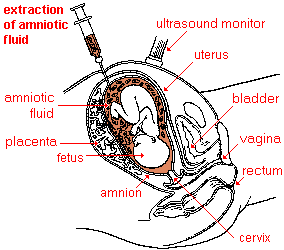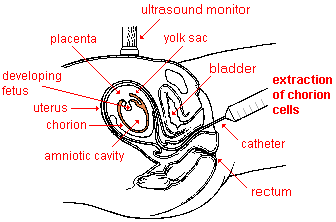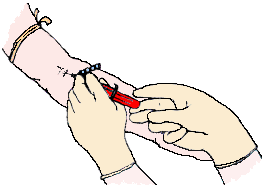Karyotyping can be done from
blood, hair, or any other tissue. However, most karyotyping for medical diagnostic
purposes is done on embryonic or fetal cells from unborn babies still in the uterus.
The cells are usually collected by one of two methods:
amniocentesis
![]() or
chorionic villi sampling
or
chorionic villi sampling
![]() . Preliminary testing is
now commonly done with a less invasive
ultrasound examination of the fetus within the
uterus and an analysis of specific fetal chemicals in the mother's blood.
The goal of all of
these tests is to determine whether or not the baby will be abnormal. This information can be the basis for a decision to perform an abortion
or to prepare parents for the difficulties of raising a child with serious
abnormalities and health problems.
. Preliminary testing is
now commonly done with a less invasive
ultrasound examination of the fetus within the
uterus and an analysis of specific fetal chemicals in the mother's blood.
The goal of all of
these tests is to determine whether or not the baby will be abnormal. This information can be the basis for a decision to perform an abortion
or to prepare parents for the difficulties of raising a child with serious
abnormalities and health problems.
Amniocentesis
Amniocentesis involves
sampling the liquid immediately surrounding a fetus within the amnion
![]() (or amniotic sac) as illustrated below. This amniotic fluid is extracted through the
mother's abdominal and uterine
(or amniotic sac) as illustrated below. This amniotic fluid is extracted through the
mother's abdominal and uterine
![]() walls with a hypodermic
needle. Local anesthesia is used for this test. The amniotic fluid mostly contains fetal urine but also has millions of
fetal skin cells that can be cultured to produce a karyotype.
Ultrasound monitoring is commonly used to
avoid harming the fetus with the needle. This entire procedure only takes a few
minutes in a doctor's office.
walls with a hypodermic
needle. Local anesthesia is used for this test. The amniotic fluid mostly contains fetal urine but also has millions of
fetal skin cells that can be cultured to produce a karyotype.
Ultrasound monitoring is commonly used to
avoid harming the fetus with the needle. This entire procedure only takes a few
minutes in a doctor's office.
 Ultrasound monitoring of a fetus |
 |
|
| Extraction of an amniotic fluid sample |
|
|
|
|
Normal
human fetus at |
Complete
results of amniocentesis tests usually come back from the laboratory in 3-4
weeks.
However, determination of gender often can be made in 1-2 days. There is 99+% accuracy in
diagnosing Down syndrome
![]() and most other gross chromosomal
aberrations including neural tube defects
and most other gross chromosomal
aberrations including neural tube defects
![]() such as spina bifida
such as spina bifida
![]() .
Amniocentesis can be used to discover the presence of about 400 specific
genetic abnormalities in a fetus. These now include
some single-gene mutations such as the one that is responsible for the blood
disorder beta-thalassemia.
.
Amniocentesis can be used to discover the presence of about 400 specific
genetic abnormalities in a fetus. These now include
some single-gene mutations such as the one that is responsible for the blood
disorder beta-thalassemia.
Amniocentesis usually is done from the 15th or 16th week after conception on up to the 20th week. In other words, it is in the 2nd trimester, which is relatively late. Only at this point in a pregnancy is there sufficient amniotic fluid to allow some of it (about 20 cc) to be drawn off without significant danger to the fetus--there is only about .3-.5% risk of the procedure causing a miscarriage. In some cases, amniocentesis is done as early as the 12th-14th week, but the risk of miscarriage is twice as high and the accuracy in detecting neural tube defects is slightly lower.
A variation of the amniocentesis procedure described above involves testing a sample of blood extracted from the umbilical cord. This has an equally high accuracy in diagnosing gross chromosomal abnormalities.
NOTE: Some medical facilities are now using an additional method to test amniotic fluid collected by amniocentesis. This new procedure is referred to as QF-PCR (quantitative fluorescent polymerase chain reaction). This allows for a more rapid discovery of abnormal chromosome numbers for chromosomes 13, 18, 21, and X. QF-PCR is still generally considered to be experimental. Research is also ongoing to be able to use amniocentesis for the purpose of detecting a range of single-gene mutations including those responsible for cystic fibrosis and Tay-Sachs disease.
Chorionic
Villi Sampling (CVS)
With chorionic villi
sampling (or biopsy), a small sample of chorion cells are collected for karyotyping.
The chorion is a membrane that develops around an embryo
![]() and contributes to the formation of the placenta
and contributes to the formation of the placenta
![]() .
Later, as a fetus develops, the chorion fuses with the amnion. The biopsy
.
Later, as a fetus develops, the chorion fuses with the amnion. The biopsy
![]() usually is done by inserting a small flexible plastic tube through the vagina
usually is done by inserting a small flexible plastic tube through the vagina
![]() and the cervix
and the cervix
![]() into the uterus to draw out a sample of chorion tissue. Alternately, the cells may be
extracted with a hypodermic needle through the abdominal and uterine walls, as in the amniocentesis
procedure. Local anesthesia also is used for this test. Ultrasound monitoring helps to prevent damage to the unborn
child.
into the uterus to draw out a sample of chorion tissue. Alternately, the cells may be
extracted with a hypodermic needle through the abdominal and uterine walls, as in the amniocentesis
procedure. Local anesthesia also is used for this test. Ultrasound monitoring helps to prevent damage to the unborn
child.
 |
| Extraction of a sample of chorion cells |
Chorionic villi sampling usually is done beginning in the 10th-12th week of pregnancy. That is still during the 1st trimester when the fetus is quite immature. Final laboratory results usually come back in 2 weeks or less. However, the reliability of those results is less than with amniocentesis. There is approximately 98% accuracy in diagnosing Down syndrome and some other conditions associated with gross chromosomal abnormalities. However, the accuracy in predicting neural tube defects is lower with CVS. The risk of miscarriage is at least 1-3%, or 2-6 times higher than with amniocentesis. As a consequence, chorionic villi sampling is less frequently performed. The risk can be reduced by performing the biopsy no earlier than the 10th week of a pregnancy.
Screening
with Maternal Blood
 |
|
Blood being drawn from a pregnant woman for AFP and other fetal chemical screening |
A much more routinely done
diagnostic procedure for pregnant women is testing their blood for
alpha-feto protein
![]() and several other chemicals originating
from their fetus.
This screening is significantly less expensive and has no risk of causing a
miscarriage. However, the information gained is less reliable
in predicting a chromosomal abnormality. Therefore,
positive AFP results are usually followed up by amniocentesis for verification.
and several other chemicals originating
from their fetus.
This screening is significantly less expensive and has no risk of causing a
miscarriage. However, the information gained is less reliable
in predicting a chromosomal abnormality. Therefore,
positive AFP results are usually followed up by amniocentesis for verification.
Alpha-feto protein is a
substance normally produced by the liver of fetuses and is carried in their blood.
Some of the fetal blood leaks into the placenta and then into the mother's blood
during pregnancy.
The AFP, and other diagnostic fetal and maternal chemicals, can be separated from a blood sample taken
from the mother's arm. Unusually high or low amounts of AFP relative to the stage of
pregnancy indicate that there may be particular kinds of genetic defects.
Specifically, it may indicate the likelihood of Down syndrome, neural tube defects,
abdominal wall defects, and trisomy 18
![]() .
.
AFP testing is routinely done in the 14th to 20th week of a pregnancy. If the date of conception has been miscalculated, a false positive test result can occur. A similar error can happen if it is unknown that there are twins, because two fetuses produce more AFP than one.
Other substances of fetal origin found in a mother's blood that are commonly tested for in addition to AFP are the hormones HCG (human chorionic gonadotropin) and unconjugated estriol. The combined testing procedure is referred to as Alpha-fetoprotein Plus or triple screening. Recently, testing for inhibin has also been added to the combined screening. Subsequently, the test is referred to as quadruple or quad screening. The American College of Obstetricians and Gynecologists guidelines now recommend that all pregnant women have triple screening blood tests and ultrasound testing in the first trimester of their pregnancies.
NOTE: Human chorionic gonadotropin is produced by the embryo and later in a pregnancy by the placenta. Unconjugated estriol is a form of estrogen that is made by the liver of the fetus and by the placenta. Inhibin-A is a hormone that plays a part in regulating the menstrual cycle. It is produced normally by the ovaries but also by the placenta during a pregnancy. A newer diagnostic blood test used by some doctors looks for the presence of PAPPA (pregnancy-associated plasma protein A). Still another new test (MaterniT21 LTD) that also involves sampling maternal blood is likely to prove the most reliable for diagnosing Down syndrome. Unlike the other procedures, it does not look for fetal proteins but rather for fetal DNA. Early indications are that it may be 99.1% accurate and have a low false positive rate.
High-resolution Sonogram Screening
The near future of pregnancy screening for birth defects is likely to focus on the new generation of high-resolution ultrasound devices that are now becoming available. They are beginning to be used by doctors who have been specially trained to detect the early anatomical signs associated with some abnormalities. Using this procedure, Down syndrome can be reliably detected in the first trimester of a pregnancy. In addition, it is possible to detect structural defects such as brain cysts and cleft-palates. An advantage of high-resolution sonograms for screening is that they do not increase the risk of miscarriage and can be done early in a pregnancy. In addition, they are relatively inexpensive and quick since there are no samples to be processed in a laboratory. However, it is unlikely in the near future that amniocentesis will stop being considered the gold standard for detecting chromosomal abnormalities.
Screening
for Abnormal DNA and RNA Sequences
Somewhat further in the future will
be prenatal blood tests to find and analyze a wide range of abnormal fetal
DNA and RNA sequences found in a pregnant woman's blood. Such tests
would have the advantages of being relatively inexpensive and noninvasive
while providing highly accurate results. One such diagnostic procedure
to discover Down syndrome, called MaterniT21, has been developed and is being tested now.
Early results indicate that it may be 99.1% accurate with no risk for the
fetus. This and other tests may largely replace amniocentesis in the
future.
|
This link takes you to an external website. To return here, you must click the "back" button on your browser program. (length = 9 mins, 27 secs) |
NOTE:
additional tests for 24-29 mostly rare genetic and
metabolic diseases are now routinely done with a little blood taken from the
heel of newborn babies. These tests are mandated by law in all 50 U.S.
states. One such test is for detecting phenylketonuria (PKU), an
inherited disorder that causes mental retardation and other neurological
problems.
.jpg)